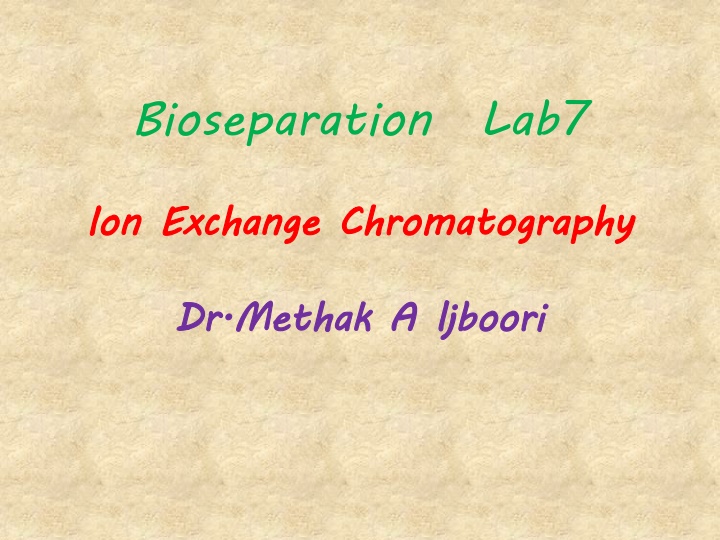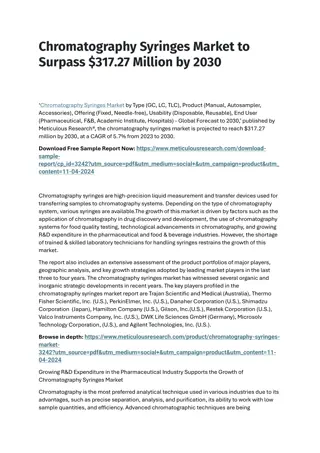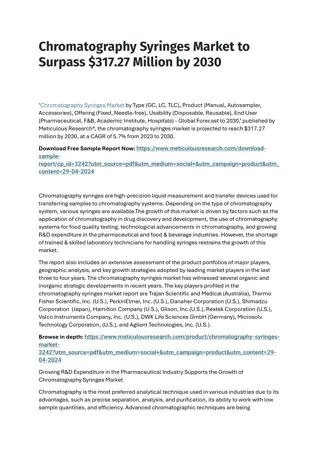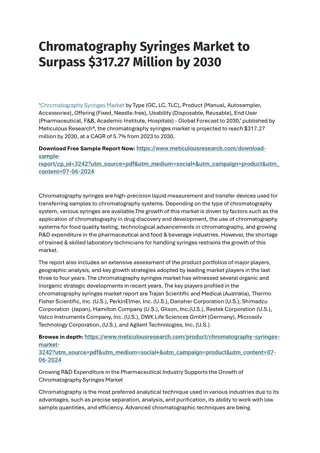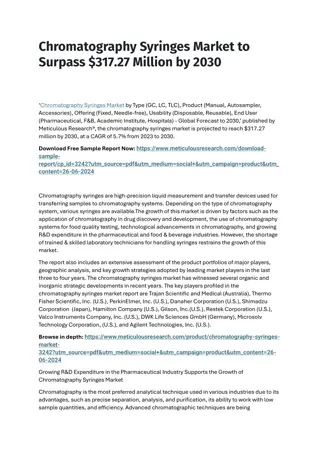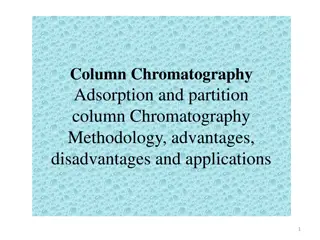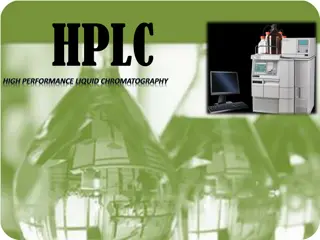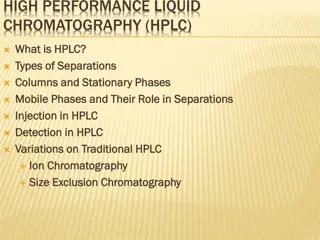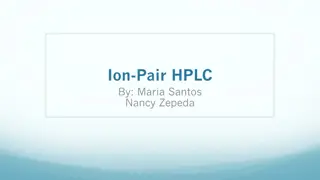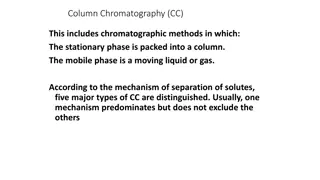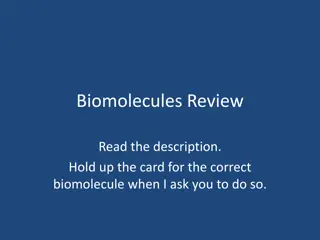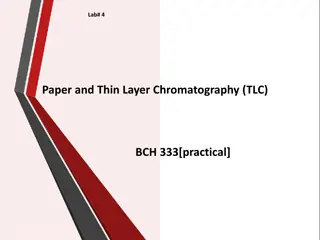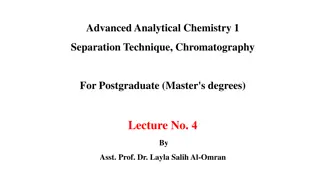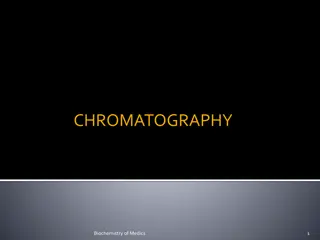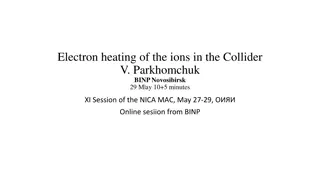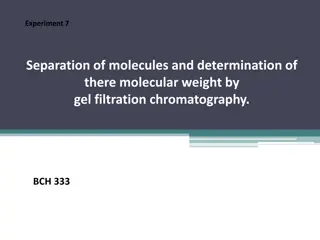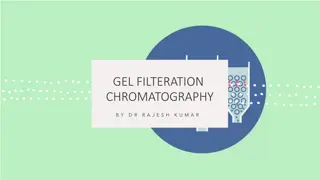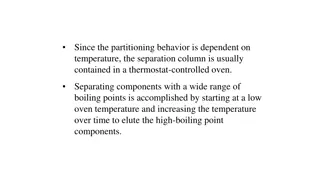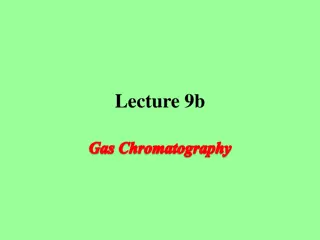Ion Exchange Chromatography: Separation Technique for Biomolecules
Ion exchange chromatography is a common technique for biomolecule purification based on charge separation. It utilizes the interaction between charged molecules in a sample and oppositely charged moieties in the stationary phase of the chromatography matrix. This method involves anion and cation exchangers to attract oppositely charged molecules for efficient separation.
Download Presentation

Please find below an Image/Link to download the presentation.
The content on the website is provided AS IS for your information and personal use only. It may not be sold, licensed, or shared on other websites without obtaining consent from the author.If you encounter any issues during the download, it is possible that the publisher has removed the file from their server.
You are allowed to download the files provided on this website for personal or commercial use, subject to the condition that they are used lawfully. All files are the property of their respective owners.
The content on the website is provided AS IS for your information and personal use only. It may not be sold, licensed, or shared on other websites without obtaining consent from the author.
E N D
Presentation Transcript
Bioseparation Lab7 Ion Exchange Chromatography Ion Exchange Chromatography Dr.Methak Dr.Methak A A ljboori ljboori
Ion Exchange Chromatography Ion exchange chromatography (IEX) is a technique that is commonly used in biomolecule the separation of molecules on the basis of their charge This technique exploits the interaction between charged molecules in a sample and oppositely charged moieties in the stationery phase of the chromatography matrix. Ion Exchange Chromatography Ion exchange chromatography (IEX) is a technique that is commonly used in biomolecule purification. It involves the separation of molecules on the basis of their charge. This technique exploits the interaction between charged molecules in a sample and oppositely charged moieties in the stationery phase of the chromatography matrix. purification. It involves
Types of Ion Exchange Types of Ion Exchange anion exchangers cation exchangers
Cation Cation exchange chromatography exchange chromatography In positively charged molecules are attracted to a negatively charged solid support. Commonly used derivatives(S ions (CM resins In cation positively charged molecules are attracted to a negatively charged solid support. Commonly used cation derivatives(S- -resin) and ions (CM resins) cation exchange chromatography exchange chromatography cation exchange resins are resin) and carboxylate exchange resins are sulfate carboxylate derived sulfate derived
Anion exchange chromatography In anion exchange chromatography, negatively charged molecules are attracted to a positively charged solid support. Commonly used anion exchange resins are Quaternary amine (Q DEAE) resin Quaternary Amino Ethane ( amine (Q- -resin); and DEAE) resin. resin); and DiEthyl DiEthyl Amino Ethane (
Principle of ion exchange chromatography IEX chromatography is used in the separation of charged biomolecules. The crude sample containing charged molecules is used as the (mobile or liquid phase When it passes through the chromatographic column, molecules bind to oppositely charged sites in the stationary phase Principle of ion exchange chromatography mobile or liquid phase). stationary phase.
The molecules separated on the basis of their charge are eluted using a solution of varying ionic strength. The molecules separated on the basis of their charge are eluted using a solution of varying ionic strength. By passing such a solution through the column, highly selective separation of molecules according to their different charges takes place By passing such a solution through the column, highly selective separation of molecules according to their different charges takes place. .
The reasons for the success of ion exchange are: 1-Its widespread applicability 2- High resolving power 3- High capacity and the simplicity 4-Controllability of the method. The reasons for the success of ion exchange are:
Pros and Cons of Ion Exchange Chromatography: Pros and Cons of Ion Exchange Chromatography: IEX Pros IEX Cons Permits high flow rate Sample must be loaded at low ionic strength Concentrates samples Clusters of positively charged residues can cause a net- negatively charged protein to bind a cation exchanger, and vice versa High yield Small changes in pH can greatly alter binding profile of IEX resin Buffers are nondenaturing Particle size greatly influences resolution
pH gradient A pH gradient can also be applied to elute individual proteins on the basis of their isoelectric which the amino acids in a protein carry neutral charge and hence do not migrate in an electric field. As amino acids are zwitter compounds positive and negative charges. Based on the pH of the environment, proteins carry a positive, negative, or nil charge. isoelectric point ( point (pI pI) ) i.e. the point at zwitter ionic ionic compounds they contain groups having both
At their interact with the charged moieties in the column resin and hence are eluted. At their isoelectric interact with the charged moieties in the column resin and hence are eluted. isoelectric point, they will not point, they will not A decreasing pH gradient can be used to elute proteins using an anion exchange resin and an increasing pH gradient can be used to elute proteins from cation exchange resins.
pH gradient This is because increasing the buffer pH of the mobile phase causes the protein to become less protonated (less positively charged) so it cannot form an ionic interaction with the negatively charged resin, allowing is elution. Conversely, lowering the pH of the mobile phase will cause the molecule to become more protonated (less negatively charged), allowing its elution.
Resin Selection in Ion Exchange Chromatography Ion exchange resins have positively or negatively charged functional groups covalently linked to a solid matrix. Matrices are usually made of cellulose, polystyrene, agarose Some of the factors affecting resin choice are : 1-Anion or cation exchanger 2- Flow rate 3- weak or strong ion exchanger 4- particle size of the resin 5- Binding capacity. Resin Selection in Ion Exchange Chromatography Ion exchange resins have positively or negatively charged functional groups covalently linked to a solid matrix. Matrices are usually made of cellulose, polystyrene, agarose, and Some of the factors affecting resin choice are , and polyacrylamide polyacrylamide. .
The Applications of Ion Exchange Chromatography 1- Separation and Purification of blood components such as albumin,recombinant growth factors and enzymes. 2- Biotechnology - Analytical applications such as quality control and process monitoring. 3- Food and clinical research - to study wheat varieties and the correlation of proteinuria with different renal diseases. 4- Fermentation - Cation exchange resins are used to monitor the fermentation process during -galactosidase production. The Applications of Ion Exchange Chromatography
Advantages It is a non-denaturing technique. It can be used at all stages and scales of purification. An IEX separation can be controlled by changing pH, salt concentration and/or the ion exchange media. It can serve as a concentrating step. A large volume of dilute sample can be applied to a media, and the adsorbed protein subsequently eluted in a smaller volume. It offers high selectivity; it can resolve molecules with small differences in charge.
Disadvantages Costly equipment and more expensive chemicals Turbidity 10ppm. should be below
Stages in Ion Exchange Chromatography The Ion Exchange process can be separated into four basic stages: 1. Equilibration 2. Application of sample 3. Elution 4. Regeneration
The Technique OF IEX: Key steps in the ion exchange chromatography procedure are: 1 1- -An crude protein sample is loaded into the ion exchange chromatography column at a particular 2 2- - Charged proteins will bind to the oppositely charged functional groups in the resin. 3 3- - A salt gradient is used to elute separated proteins. At low salt concentrations, proteins having few charged groups are eluted and at higher salt concentrations, proteins with several charged groups are eluted. 4 4- - Unwanted proteins and impurities are removed by washing the column. An crude protein sample is loaded into the ion exchange chromatography column at a particular pH. Charged proteins will bind to the oppositely charged functional groups in the resin. A salt gradient is used to elute separated proteins. At low salt concentrations, proteins having few charged groups are eluted and at higher salt concentrations, proteins with several charged groups are eluted. Unwanted proteins and impurities are removed by washing the column. pH.
Procedure Ion exchange chromatography column DEAE- Sephadex preparation DEAE- Sephadex gel have positive charged groups(Anion exchangers). 1- Dissolve (10g) of gel powder in 100 ml D.W 2-Left the powder to settle down, remove the supernatant and repeat dissolving in water for several times until it was become completely clear. 3- Degas the gel by using vacuum pump. Ion exchange chromatography column
4- Activate DEAE-Sephadex gel with 0.25 M NaCl for 30 min and wash it with D.W . 5- Pour the gel into column and left to package. 6- Equilibrate the column with equilibration buffer.
Column preparation 1- Apply the dialysed enzyme to DEAE equilibrate the column and wash it with an equal volume of 0.01M phosphate buffer solution (pH 7) to wash uncharged and positively charged proteins in the sample. Column preparation sephadex column then
2- Elution the bound proteins (negatively charged) by using gradient concentrations of sodium chloride ranged between 0.1 and 0.5 M. 3- Detect all protein peaks by measuring the absorbance at 280 nm of each eluted fraction by using UV spectrophotometer.
NaCl It was prepared by dissolving 1.461g of NaCl in100ml D.W. Sodium chloride phosphate Solution It was prepared at different concentrations of NaCl ( 0.1, 0.2, 0.3, 0.4, and 0.5 M) in 20mM Potassium phosphate buffer. 0.1M NaCl =0.5844 gm in 100ml DW 0.2M NaCl =1.1688 gm in 100ml DW 0.3M NaCl =1,7532 gm in 100ml DW 0.4M NaCl =2.3376 gm in 100ml DW 0.5M NaCl =2.922 gm in 100ml DW NaCl ( (0.25 0.25 M): M): Sodium chloride phosphate Solution
